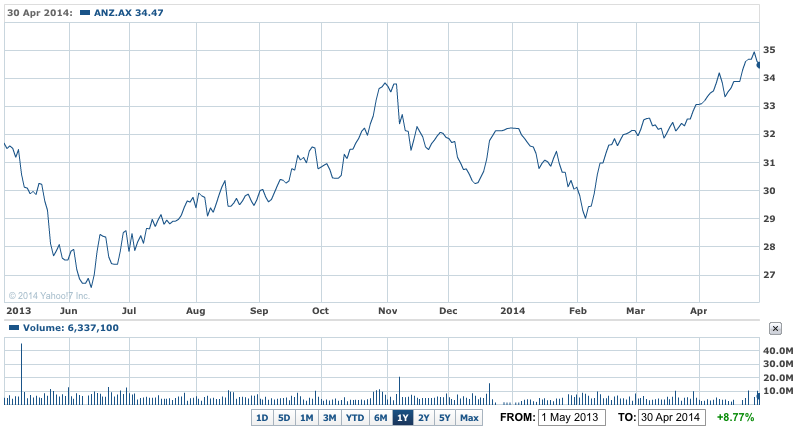The ANZ justified the rapid run up in its share price by reporting a solid 11% rise in cash earnings to a record $3.4 billion, and will lift interim payout to shareholders by 14%, to a record 83 cents a share.
The bank revealed its record breaking numbers before the market opened this morning.
The interim dividend is up 10 cents a share from the 73 cents paid for the first half of 2012-13.
The company said higher results from Asia, NZ and its Australian business, where it lifted lending to home owners and small business, plus a lower provisioning across the group, drove the surge in earnings.
NZ earnings jumped 21% as home building and the economy generally rebounded strongly.
But the bank buried a 5% fall in cash earnings from its Australian businesses, to $2.025 billion, in the half year, a bit of news that won’t please investors and analysts.
The shares closed down yesterday at $34.47, about 40 cents or so below the record levels of earlier in the week.
News of the fall in Australian earnings will see the share price under some pressure today while investors analyse the ANZ’s explanation.
The ANZ said its cash profit of $3.5 billion for the six months to March 31, was up from $3.2 billion for the same period last year.
Net profit was $3.4 billion, up 15% from $2.9 billion a year ago.
Banking analysts had been expecting a result of $3.4 billion and an interim dividend of 80c a share, so the ANZ beat those expectations.
ANZ 1Y – ANZ beats expectations, ups dividend

Chief executive Mike Smith said in this morning’s statement the result showed solid growth from Australia and New Zealand and a strong performance from its international division.
‘Our international business, particularly Asia, is firing on all cylinders with revenue and profits again growing strongly, and a sustained improvement in returns,’ he said.
Profit from the bank’s Australian division rose 5%, thanks to strong growth in home loans and loans to small businesses.
“In Australia we are seeing ongoing benefits emerge from the investment in our Banking on Australia program which includes new digital solutions for our customers. We have developed greater scale based on market share growth in home lending, small business lending and retail deposits," Mr Smith said.
"Business confidence in Australia is recovering more slowly than expected however, and in some segments growth remains subdued with competition placing pressure on margins. Costs were carefully managed in this environment.
"Building on a strong performance in 2013, the Australia Division grew profit 5%, reflecting 4% income growth, a 2% increase in expenses and a 4% increase in the provision charge. Lending grew 6% with customer deposits up 7%," Mr Smith said.
ANZ said it had the strongest home loan growth of the major banks over the past year and has grown home loans at above system for 17 consecutive quarters.
"Small Business Banking has performed particularly strongly with lending up 16%. To date ANZ has lent $1.2 billion to new Australian small businesses as part of our $2 billion pledge, while maintaining credit quality.
“In New Zealand after several years of hard work our business is in a winning position. ANZ’s move to a single brand and technology platform together with New Zealand’s economic recovery saw volume growth, improved productivity and lower provisions," he added.
ANZ said the quality of its loan book continued to strengthen with the provision charge of $528 million or 12% lower than a year ago.
"Gross impaired assets decreased 23%. Impaired assets are down 32% over the last two years, and are lower than at any point since September 2008 despite 46% growth in the lending book in that time. While ANZ continues to expect that the provision charge for FY14 will be around 10% lower than for FY13 it maintains a strong provision balance."
Net interest income fell to 2.15% from 2.24% (that’s 2.15 cents in every dollar against 2.24 cents in every dollar of income).
The bank’s cost to income ratio, a key performance measure fell 0.20 to 44.3% (or 44.3 cents in every dollar of income).
The bank’s return on equity was steady on 15.5%, which will worry some of the greedy banking analysts and big investors who look for this metric to rise in every statement.













